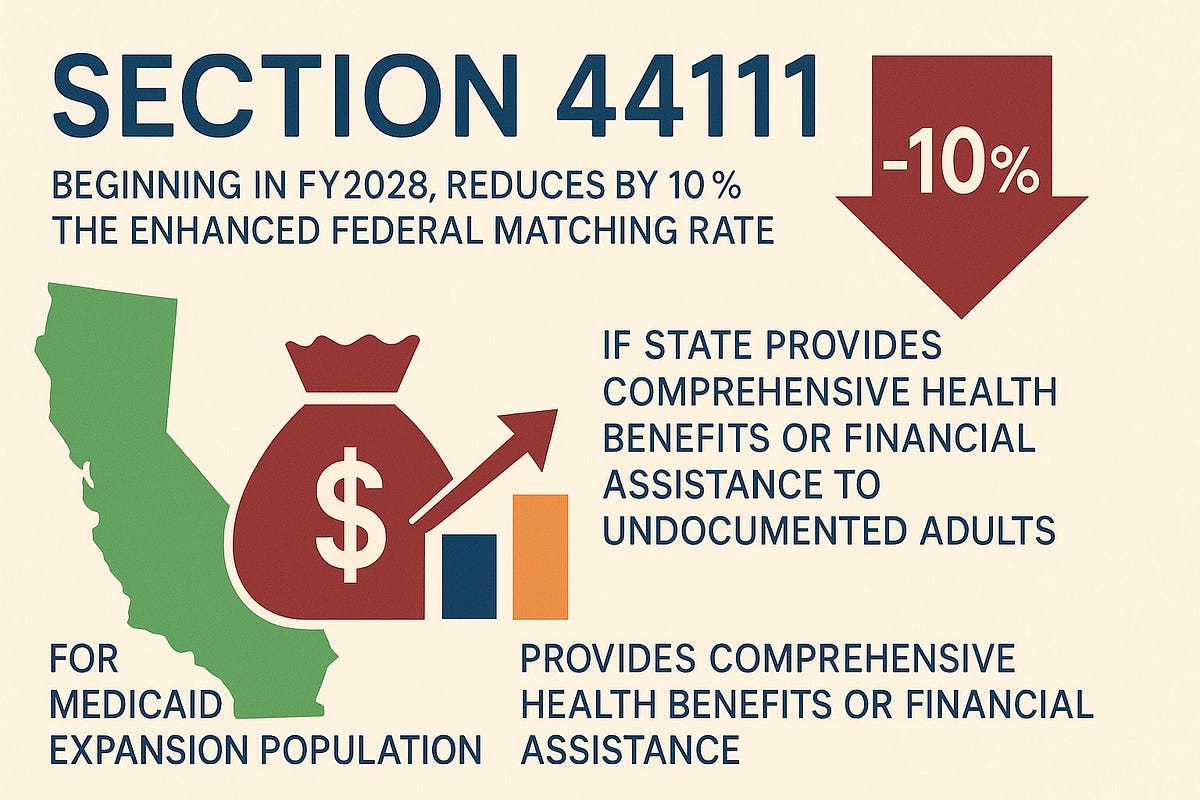Imagine a Medicaid expansion state spending roughly $1 billion a year on its adult expansion enrollees. Today, the federal treasury contributes $900 million, while the state contributes $100 million. Under Section 44111, the federal contribution would fall to $800 million. Unless lawmakers roll back coverage or raise new revenue, the state would need to come up with an additional $100 million annually to maintain current benefits. That extra burden arrives on top of existing pressures, including wage inflation among clinical staff, the lingering costs of unwinding the public health emergency, and perennial state budget fights over education, transportation, and pensions.
Section 44111 of the One Big Beautiful Bill Act seeks to discourage states from offering publicly funded health coverage to undocumented adults by raising each affected state’s financial stake in the Affordable Care Act’s Medicaid expansion. Beginning October 1, 2027, the first day of the federal fiscal year 2028, the federal match for a state’s expansion population falls by ten percentage points when that state “provides comprehensive health benefits or financial assistance for purchasing health benefits to individuals who are not lawfully residing in the United States, other than children or pregnant women” Because the ACA’s enhanced Federal Medical Assistance Percentage (FMAP) is currently set at 90 percent, the policy would reduce that match to 80 percent for any state that maintains broad‐based coverage or subsidies for undocumented adults. In turn, the state share would jump from 10 percent to 20 percent, effectively doubling a state’s required outlay for every dollar spent on the expansion group.
California’s Medi-Cal program, New York’s Essential Plan, Illinois’s Health Benefits for Immigrant Adults initiative, and a handful of smaller pilot programs in Oregon, Massachusetts, and Washington State currently finance at least some form of full-scope coverage for undocumented adults using state-only dollars. California alone anticipates spending more than $3 billion next year to extend full Medi-Cal eligibility to residents aged nineteen to sixty-four who lack lawful status. If Section 44111 becomes law, California would face an estimated annual loss of $750 million to $1 billion in federal support for its expanding population, an amount equivalent to the entire general-fund appropriation of a mid-sized public university. Even states that confine assistance to premium subsidies for marketplace plans could trigger the same penalty, because the statutory language reaches “financial assistance… regardless of the source,”
How states may respond: State budget writers have four main levers:
- Scale back or repeal immigrant coverage. Politically contentious but fiscally straightforward, this approach would preserve the 90 percent match while allowing hospitals to cope with higher uncompensated care loads.
- Absorb the extra 10 percent. High-revenue states might accept the surcharge, framing immigrant coverage as a public-health investment. That choice, however, could crowd out other priorities, such as expanding behavioral health services or subsidizing graduate medical education.
- Cut provider payment rates. Lowering Medicaid reimbursement spreads the fiscal pain to hospitals, health systems, and community clinics. For large safety-net hospitals, even a three-to-five-percent rate cut can erode annual operating margins.
- Seek new revenue. Options include provider taxes, assessment on managed-care organizations, or earmarked sin-tax hikes — each requiring its legislative coalition.
From the perspective of a health-system administrator, Section 44111 signals several operational risks:
- Reimbursement volatility. If your state lowers base Medicaid rates to stay solvent, revenue projections tied to expansion patients will soften. That hits service lines like behavioral health and maternity care first, because they already run on slim financial margins.
- Payer-mix shifts. Should the state retract coverage for undocumented adults, many of those individuals will surface in emergency departments classified as self-pay. The shift increases bad-debt expense and raises administrative overhead associated with charity-care policies.
- Strategic capital planning. Any deceleration in Medicaid cash flow can constrict debt-capacity ratios, complicating approvals for upcoming facility upgrades or new service lines.
- Workforce recruitment. Budget stress at the state level often slows rate increases that help hospitals keep pace with wage competition. A pause in Medicaid rate growth may hinder efforts to recruit nurses, respiratory therapists, and other high-demand staff.
Fiscal year 2028 begins in just over three years. That interval offers time for scenario modelling, legislative engagement, and alignment with community partners. Recommended steps include:
- Quantify exposure. Model your organization’s projected expansion-population revenue through FY 2029, then stress-test against an eight-to-twelve-percent rate reduction or a payer-mix shift toward uncompensated care. Integrate those scenarios into your long-range financial plan.
- Engage state associations. Hospital and medical group associations will develop joint advocacy positions. Early involvement ensures that provider data, rather than generic estimates, inform legislative debate.
- Monitor budget preparatory sessions. The first significant clues will surface in each state’s FY 2027 governor’s budget, which must build in projections for FY 2028. Track draft language around coverage rescission, eligibility tightening, or new revenue streams.
- Strengthen community safety-net collaboration. If undocumented adults lose coverage, federally qualified health centers (FQHCs) and county clinics will shoulder higher patient loads. Align referral pathways now to avoid bottlenecks in emergency departments later.
- Diversify payer contracts. Explore commercial or Medicare Advantage partnerships that offset possible Medicaid contraction. For integrated systems, accelerated value-based contracts can create alternate revenue linked to quality benchmarks rather than fee schedules.
Although Section 44111 is framed as a budgetary incentive, its downstream effects extend to clinical practice. Studies repeatedly show that deferring primary and preventive care for undocumented adults increases avoidable hospitalizations for conditions such as uncontrolled diabetes and hypertension. Those admissions are costlier than the outpatient care they replace and often result in lower collection rates. Hospitals ultimately absorb some of that cost through community-benefit requirements, while county health departments confront spillover outbreaks of communicable disease. Transparent discussion of these externalities with policymakers can reframe the debate from “state savings” to “cost shifting” — a distinction legislators sometimes overlook.
